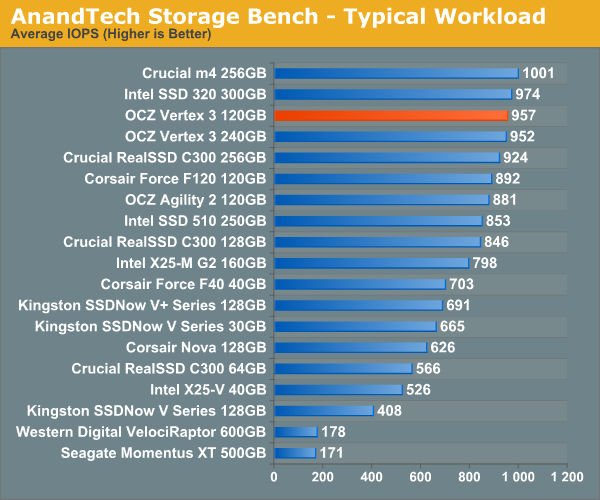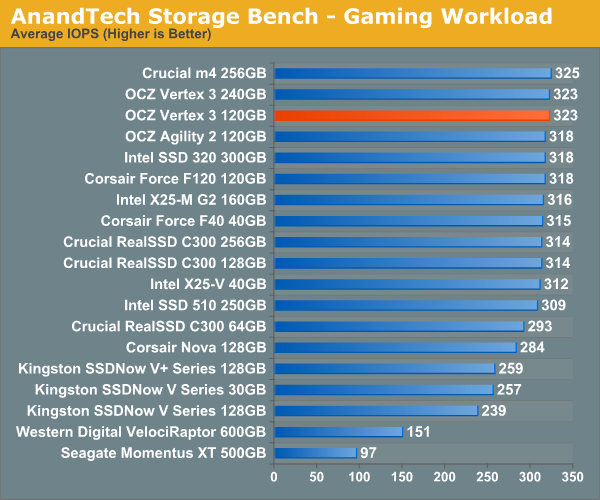The OCZ Vertex 3 Review (120GB)
by Anand Lal Shimpi on April 6, 2011 6:32 PM ESTAnandTech Storage Bench 2010
To keep things consistent we've also included our older Storage Bench. Note that the old storage test system doesn't have a SATA 6Gbps controller, so we only have one result for the 6Gbps drives.
The first in our benchmark suite is a light/typical usage case. The Windows 7 system is loaded with Firefox, Office 2007 and Adobe Reader among other applications. With Firefox we browse web pages like Facebook, AnandTech, Digg and other sites. Outlook is also running and we use it to check emails, create and send a message with a PDF attachment. Adobe Reader is used to view some PDFs. Excel 2007 is used to create a spreadsheet, graphs and save the document. The same goes for Word 2007. We open and step through a presentation in PowerPoint 2007 received as an email attachment before saving it to the desktop. Finally we watch a bit of a Firefly episode in Windows Media Player 11.
There’s some level of multitasking going on here but it’s not unreasonable by any means. Generally the application tasks proceed linearly, with the exception of things like web browsing which may happen in between one of the other tasks.
The recording is played back on all of our drives here today. Remember that we’re isolating disk performance, all we’re doing is playing back every single disk access that happened in that ~5 minute period of usage. The light workload is composed of 37,501 reads and 20,268 writes. Over 30% of the IOs are 4KB, 11% are 16KB, 22% are 32KB and approximately 13% are 64KB in size. Less than 30% of the operations are absolutely sequential in nature. Average queue depth is 6.09 IOs.
The performance results are reported in average I/O Operations per Second (IOPS):

If there’s a light usage case there’s bound to be a heavy one. In this test we have Microsoft Security Essentials running in the background with real time virus scanning enabled. We also perform a quick scan in the middle of the test. Firefox, Outlook, Excel, Word and Powerpoint are all used the same as they were in the light test. We add Photoshop CS4 to the mix, opening a bunch of 12MP images, editing them, then saving them as highly compressed JPGs for web publishing. Windows 7’s picture viewer is used to view a bunch of pictures on the hard drive. We use 7-zip to create and extract .7z archives. Downloading is also prominently featured in our heavy test; we download large files from the Internet during portions of the benchmark, as well as use uTorrent to grab a couple of torrents. Some of the applications in use are installed during the benchmark, Windows updates are also installed. Towards the end of the test we launch World of Warcraft, play for a few minutes, then delete the folder. This test also takes into account all of the disk accesses that happen while the OS is booting.
The benchmark is 22 minutes long and it consists of 128,895 read operations and 72,411 write operations. Roughly 44% of all IOs were sequential. Approximately 30% of all accesses were 4KB in size, 12% were 16KB in size, 14% were 32KB and 20% were 64KB. Average queue depth was 3.59.

The gaming workload is made up of 75,206 read operations and only 4,592 write operations. Only 20% of the accesses are 4KB in size, nearly 40% are 64KB and 20% are 32KB. A whopping 69% of the IOs are sequential, meaning this is predominantly a sequential read benchmark. The average queue depth is 7.76 IOs.











153 Comments
View All Comments
Super - Friday, April 8, 2011 - link
...perhaps the Nobel Peace Prize. ?? i've seen someone win it for a whole lot less *cough ObamaA5 - Wednesday, April 6, 2011 - link
Agreed - glad they listen to Anand.The real question is why they didn't do anything until Anand bitched to the CEO directly. It's not like they weren't aware of the issue - the Storage Review article came out several months ago...
darckhart - Wednesday, April 6, 2011 - link
It just goes to show that companies are not customer focused. Unless they get shoved hard enough, or see that the bottom line will be affected greatly, they just hope you'll give up after being mired in the revolving email chain or sent through 5 level deep phone support.Thanks Anand for reminding companies that some of us are still capable of making informed decisions and aren't afraid to express our dissatisfaction with our dollars.
789427 - Thursday, April 7, 2011 - link
It's not about being customer focussed or not. Quite frankly, what percentage of upgraders will go into this level of detail?Furthermore, 25nm sounds better than 35nm to most people and that's salesmen included.
After all that, it's a victory for transparency for a tiny few.
In terms of marketing, there's little you can do except re-brand the entire product range.
e.g. Silver and Silver Pro for the lower capacities, Gold and Gold Pro for the higher capacities and explain on the box that fewer chips means generally lower performance
The problem here is that this is the cutting edge of technology and that in 12 months time, it will be surpassed. Then how do you re-vamp the line?
Graphics cards have this problem too and the model numbers are baffling for 99% of first-time buyers.
What I would advocate is a sticker valid for 3 months on the product that lets you know which product in terms of performance you are buying and a URL you can visit to check for an update.
e.g.
Your product: xyz 300-35
is better than xyz 300-24
but is worse than 300-ii
Check Real performance figures here: URL
Then it would be nice for salesmen to allow customers to verify this.
cb
cactusdog - Wednesday, April 6, 2011 - link
Yep, at least OCZ have made a commitment not to use slow hynix nand and are being more transparent with real world performance but its all too little too late.Branding drives with the 25 or 34nm prefix is redundant now that all(or most) nand being produced is 25nm. Ocz made no real attempt to fix the problem when they needed to, and continued to sell the drives even after the consumer backlash.
I disagree with Anand that other manufacturers of sandforce controller drives hide the specs as OCZ did. Corsair rebranded their 25nm drives from the start. Other non sandforce drives from Intel also rebranded their 25nm drives.
Its true that many companies use different components and use the same branding but rarely does the performance vary as much as 30%. 30% is a huge and not acceptable for high end expensive parts..
Its a pity Anand didnt really have anything to add on the Spectek issue that hasnt already been said. I find it hard to believe a company like Micron would sell very expensive nand cheaper to Spectek unless there is some problem with it.
Saying Spectek nand must be OK because it is still rated at 3000 cycles doesnt sound very thorough or tell us the whole story. The cycle rating could have very different testing standards between Micron and Spectek.
I would have thought it would be easy for someone like Anand to ask Micron or Spectek if the Spectek nand is tier 1 nand or not. I wouldnt trust OCZ response given their track record.
Overall though thanks Anand for sticking up for the consumers.
Powerlurker - Wednesday, April 6, 2011 - link
According to their corporate website "SpecTek began at Micron in 1988 as a component-recovery group." which would lead me to believe that they're Micron's low-end brand for disposing of lower performing dies.Xneb - Thursday, April 7, 2011 - link
That is correct. testing is the same though so end users should not be able to tell the difference between spectek and imft nand in these drives.sleepeeg3 - Thursday, April 7, 2011 - link
You can't fault him for reporting honestly. There is no concrete data that shows Spectek NAND is inferior to Micron.Alkapwn - Wednesday, April 6, 2011 - link
Ditto! Keep up the great work! We all appreciate it greatly!Mr Perfect - Thursday, April 7, 2011 - link
Yes, thank you for addressing the Vertex 2 issue.The sad part is that if OCZ had used their new, transparent labeling scheme from day one, they would have been praised for their transparency and all of the other companies would have been expected to rise to their standard. Instead, they waited through months of consumer and press outcry, meaning this fair and honest SKU system is merely re-earning lost trust.